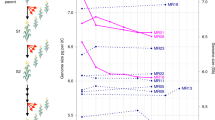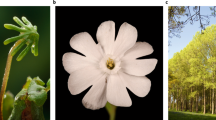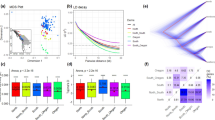Abstract
In mammals and seed plants, a subset of genes is regulated by genomic imprinting where an allele’s activity depends on its parental origin. The parental conflict theory suggests that genomic imprinting evolved after the emergence of an embryo-nourishing tissue (placenta and endosperm), resulting in an intragenomic parental conflict over the allocation of nutrients from mother to offspring1,2. It was predicted that imprinted genes, which arose through antagonistic co-evolution driven by a parental conflict, should be subject to positive darwinian selection3. Here we show that the imprinted plant gene MEDEA (MEA)4,5, which is essential for seed development, originated during a whole-genome duplication 35 to 85 million years ago. After duplication, MEA underwent positive darwinian selection consistent with neo-functionalization and the parental conflict theory. MEA continues to evolve rapidly in the out-crossing species Arabidopsis lyrata but not in the self-fertilizing species Arabidopsis thaliana, where parental conflicts are reduced. The paralogue of MEA, SWINGER (SWN; also called EZA1)6, is not imprinted and evolved under strong purifying selection because it probably retained the ancestral function of the common precursor gene. The evolution of MEA suggests a late origin of genomic imprinting within the Brassicaceae, whereas imprinting is thought to have originated early within the mammalian lineage7.
This is a preview of subscription content, access via your institution
Access options
Subscribe to this journal
Receive 51 print issues and online access
$199.00 per year
only $3.90 per issue
Buy this article
- Purchase on Springer Link
- Instant access to full article PDF
Prices may be subject to local taxes which are calculated during checkout


Similar content being viewed by others
Change history
15 November 2007
An Erratum to this paper has been published: https://doi.org/10.1038/nature06439
References
Haig, D. & Westoby, M. Parent-specific gene expression and the triploid endosperm. Am. Nat. 134, 147–155 (1989)
Smith, F. M., Garfield, A. S. & Ward, A. Regulation of growth and metabolism by imprinted genes. Cytogenet. Genome Res. 113, 279–291 (2006)
McVean, G. T. & Hurst, L. D. Molecular evolution of imprinted genes: no evidence for antagonistic coevolution. Proc. R. Soc. Lond. B 264, 739–746 (1997)
Grossniklaus, U., Vielle-Calzada, J. P., Hoeppner, M. A. & Gagliano, W. B. Maternal control of embryogenesis by MEDEA, a Polycomb group gene in Arabidopsis. Science 280, 446–450 (1998)
Vielle-Calzada, J. P. et al. Maintenance of genomic imprinting at the Arabidopsis medea locus requires zygotic DDM1 activity. Genes Dev. 13, 2971–2982 (1999)
Chanvivattana, Y. et al. Interaction of Polycomb-group proteins controlling flowering in Arabidopsis. Development 131, 5263–5276 (2004)
Walter, J. & Paulsen, M. The potential role of gene duplications in the evolution of imprinting mechanisms. Hum. Mol. Genet. 12 (review issue 2). R215–R220 (2003)
Kiyosue, T. et al. Control of fertilization-independent endosperm development by the MEDEA Polycomb gene in Arabidopsis. Proc. Natl Acad. Sci. USA 96, 4186–4191 (1999)
Goodrich, J. et al. A Polycomb-group gene regulates homeotic gene expression in Arabidopsis. Nature 386, 44–51 (1997)
Baumbusch, L. O. et al. The Arabidopsis thaliana genome contains at least 29 active genes encoding SET domain proteins that can be assigned to four evolutionarily conserved classes. Nucleic Acids Res. 29, 4319–4333 (2001)
Blanc, G., Hokamp, K. & Wolfe, K. H. A recent polyploidy superimposed on older large-scale duplications in the Arabidopsis genome. Genome Res. 13, 137–144 (2003)
Simillion, C., Vandepoele, K., Van Montagu, M. C., Zabeau, M. & Van de Peer, Y. The hidden duplication past of Arabidopsis thaliana. Proc. Natl Acad. Sci. USA 99, 13627–13632 (2002)
Bowers, J. E., Chapman, B. A., Rong, J. & Paterson, A. H. Unravelling angiosperm genome evolution by phylogenetic analysis of chromosomal duplication events. Nature 422, 433–438 (2003)
Springer, N. M. et al. Sequence relationships, conserved domains, and expression patterns for maize homologs of the Polycomb group genes E(z), esc, and E(Pc). Plant Physiol. 128, 1332–1345 (2002)
Springer, N. M. et al. Comparative analysis of SET domain proteins in maize and Arabidopsis reveals multiple duplications preceding the divergence of monocots and dicots. Plant Physiol. 132, 907–925 (2003)
Mayama, T., Ohtsubo, E. & Tsuchimoto, S. Isolation and expression analysis of petunia CURLY LEAF-like genes. Plant Cell Physiol. 44, 811–819 (2003)
Thakur, J. K. et al. A Polycomb group gene of rice (Oryza sativa L. subspecies indica), OsiEZ1, codes for a nuclear-localized protein expressed preferentially in young seedlings and during reproductive development. Gene 314, 1–13 (2003)
Ohad, N. et al. A mutation that allows endosperm development without fertilization. Proc. Natl Acad. Sci. USA 93, 5319–5324 (1996)
Chaudhury, A. M. et al. Fertilization-independent seed development in Arabidopsis thaliana. Proc. Natl Acad. Sci. USA 94, 4223–4228 (1997)
Guitton, A. E. et al. Identification of new members of FERTILISATION INDEPENDENT SEED Polycomb group pathway involved in the control of seed development in Arabidopsis thaliana. Development 131, 2971–2981 (2004)
Köhler, C. et al. Arabidopsis MSI1 is a component of the MEA/FIE Polycomb group complex and required for seed development. EMBO J. 22, 4804–4814 (2003)
Wang, D., Tyson, M. D., Jackson, S. S. & Yadegari, R. Partially redundant functions of two SET-domain Polycomb-group proteins in controlling initiation of seed development in Arabidopsis. Proc. Natl Acad. Sci. USA 103, 13244–13249 (2006)
Yang, Z. & Bielawski, J. Statistical methods for detecting molecular adaptation. Trends Ecol. Evol. 15, 496–503 (2000)
Bielawski, J. P. & Yang, Z. A maximum likelihood method for detecting functional divergence at individual codon sites, with application to gene family evolution. J. Mol. Evol. 59, 121–132 (2004)
Schmid, K. J., Ramos-Onsins, S., Ringys-Beckstein, H., Weishaar, B. & Mitchell-Olds, T. A multilocus sequence survey in Arabidopsis thaliana reveals a genome-wide departure from a neutral model of DNA sequence polymorphism. Genetics 169, 1601–1615 (2005)
Baroux, C., Gagliardini, V., Page, D. R. & Grossniklaus, U. Dynamic regulatory interactions of Polycomb group genes: MEDEA autoregulation is required for imprinted gene expression in Arabidopsis. Genes Dev. 20, 1081–1086 (2006)
Alonso, J. M. et al. Genome-wide insertional mutagenesis of Arabidopsis thaliana. Science 301, 653–657 (2003)
Adachi, J. H. M. MOLPHY Version 2.3: Programs for molecular phylogenetics based on Maximum Likelihood. Comp. Sci. Monogr. 28, 1–150 (1996)
Yang, Z. & Nielsen, R. Synonymous and non-synonymous rate variation in nuclear genes of mammals. J. Mol. Evol. 46, 409–418 (1998)
Rozas, J., Sanchez-DelBarrio, J. C., Messeguer, X. & Rozas, R. DNAsp, DNA polymorphism analyses by the coalescent and other methods. Bioinformatics 19, 2496–2497 (2003)
Coen, E. S. et al. floricaula: a homeotic gene required for flower development in Antirrhinum majus. Cell 63, 1311–1322 (1990)
Jackson, D., Culianez-Macia, F., Prescott, A. G., Roberts, K. & Martin, C. Expression patterns of myb genes from Antirrhinum flowers. Plant Cell 3, 115–125 (1991)
Huang, S., An, Y. Q., McDowell, J. M., McKinney, E. C. & Meagher, R. B. The Arabidopsis ACT11 actin gene is strongly expressed in tissues of the emerging inflorescence, pollen, and developing ovules. Plant Mol. Biol. 33, 125–139 (1997)
Yang, Z. & Nielsen, R. Estimating synonymous and nonsynonymous substitution rates under realistic evolutionary models. Mol. Biol. Evol. 17, 32–43 (2000)
Yang, Z. & Nielsen, R. Codon-substitution models for detecting molecular adaptation at individual sites along specific lineages. Mol. Biol. Evol. 19, 908–917 (2002)
Schmid, K. J., Ramos-Onsins, S., Ringys-Beckstein, H., Weisshaar, B. & Mitchell-Olds, T. A multilocus sequence survey in Arabidopsis thaliana reveals a genome-wide departure from a neutral model of DNA sequence polymorphism. Genetics 169, 1601–1615 (2005)
Nei, M. Molecular Evolutionary Genetics (Columbia Univ. Press, New York, 1987)
Tajima, F. Statistical method for testing the neutral mutation hypothesis by DNA polymorphism. Genetics 123, 585–595 (1989)
Fay, J. C. & Wu, C.-I. Hitchhiking under positive Darwinian selection. Genetics 155, 1405–1413 (2000)
McDonald, J. & Kreitman, M. Adaptive evolution at the Adh locus in Drosophila. Nature 351, 652–654 (1991)
Hudson, R. R., Kreitman, M. & Aguade, M. A test of neutral molecular evolution based on nucleotide data. Genetics 116, 153–159 (1987)
Acknowledgements
We thank J. Gheyselinck and P. Kopf for the technical support; C. O’Mahony for assistance with artwork and figures; M. O’ Connell for comments on the manuscript; and T. Mitchell-Olds, M. Clauss, R. Oyama, J. Goodrich and NASC for seeds. This work was supported by the University of Zürich, a UNESCO fellowship (to J.-M.E.-R.), the EU Network of Excellence ‘EPIGENOME‘, and grants of the Swiss National Science Foundation (to U.G.), the Deutsche Forschungsgemeinschaft and the Max Planck Society (to K.J.S.), and the Science Foundation Ireland (to C.S. and K.H.W.).
Sequences generated in this study are available from GenBank (accession numbers DQ975464–DQ975465).
Author information
Authors and Affiliations
Corresponding authors
Ethics declarations
Competing interests
Reprints and permissions information is available at www.nature.com/reprints. The authors declare no competing financial interests.
Supplementary information
Supplementary Information
This file contains Supplementary Tables S1-S9 and Supplementary Figures S1-S3 with Legends. (PDF 784 kb)
Rights and permissions
About this article
Cite this article
Spillane, C., Schmid, K., Laoueillé-Duprat, S. et al. Positive darwinian selection at the imprinted MEDEA locus in plants. Nature 448, 349–352 (2007). https://doi.org/10.1038/nature05984
Received:
Accepted:
Issue Date:
DOI: https://doi.org/10.1038/nature05984
This article is cited by
-
Gametophytic epigenetic regulators, MEDEA and DEMETER, synergistically suppress ectopic shoot formation in Arabidopsis
Plant Cell Reports (2024)
-
Analysis of polycomb repressive complex 2 (PRC2) subunits in Picea abies with a focus on embryo development
BMC Plant Biology (2023)
-
Apomixis: A Foresight from Genetic Mechanisms to Molecular Perspectives
The Botanical Review (2022)
-
Adaptive evolution driving the young duplications in six Rosaceae species
BMC Genomics (2021)
-
Identification of polycomb repressive complex 1 and 2 core components in hexaploid bread wheat
BMC Plant Biology (2020)
Comments
By submitting a comment you agree to abide by our Terms and Community Guidelines. If you find something abusive or that does not comply with our terms or guidelines please flag it as inappropriate.



